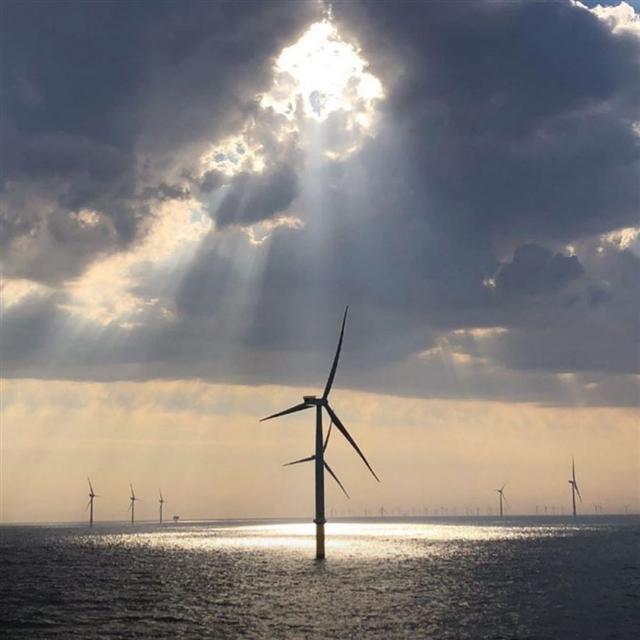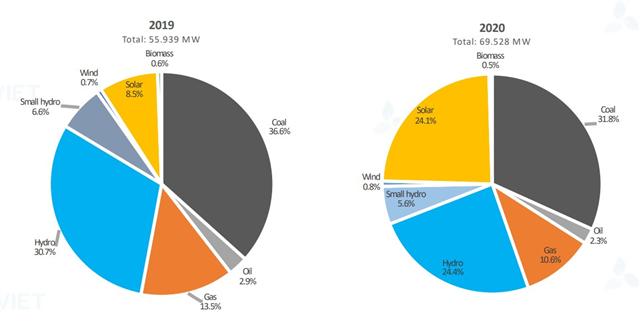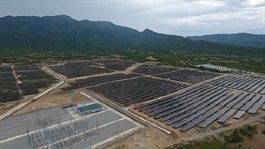Vietnam power plan drives away offshore wind power
Vietnam power plan drives away offshore wind power
Vietnam is urged to have an offshore wind roadmap to convince investors that this kind of energy has a central role to play in the years to come.
About 2,000 megawatts (MW) offshore wind power is likely slashed in the Vietnamese draft Power Development Plan VIII (PDP8) for 2021-2030 and vision to 2045, dashing people’ hopes of laying the foundation for a vibrant new industry in Vietnam despite its world-class natural conditions.

Offshore wind power in Vietnam is nascent but potential. Photo: Ørsted |
The master plan, once approved by the government, could put brakes on the promising sector in its infancy shortly after the blueprint was released for public viewing in mid-September.
In the plan built by the Ministry of Industry and Trade (MoIT), Vietnam expects to raise coal-fired power by 3,000 MW while cutting 4,200 MW of wind energy, including 2,000 MW offshore wind power.
The move is called “a step backward” the environmentally friendly development that Vietnam is pursuing to catch up with the global trend.
In the latest move, at the virtual workshop titled “Power plan 8: paving the way or driving back the green shift roadmap” held on Sept 16 by the Green Innovation and Development Center (GreenID), a number of scientists, environmental advocates, and businesses expressed concerns over both environmental and economic consequences if the government insists on keeping thermal power.
Before seeing how bad the coal-dependent trend could be, it’s better to give a snapshot of offshore wind power to see that it's nascent but potential.
Vietnam is a coastal country with potential offshore wind power and high-quality human resources for offshore wind farms, such as PVN subsidiaries, said Ngo Thi To Nhien, executive director of the Vietnam Initiative for Energy Transition (VIETSE), the first think tank in Vietnam specializing in energy transition and climate protection.
The increasing annual demand for electricity together with risky coal power would facilitate the development of offshore wind, enabling it to be one of Vietnam’s major energy sources thanks to wind turbines’ high capacity factor (CF) which is as high as thermal power plants, Nhien told The Hanoi Times.
Vietnam has some of the best conditions in Asia for developing offshore wind power projects, according to Vietnam Country Manager at Ørsted Sebastian Hald Buhl said in an interview with The Hanoi Times. With 3,000 km of coastline, shallow water depths, and high consistent wind speed, Vietnam offers crucial pre-conditions needed to develop low-cost and reliable offshore wind power projects.
Official estimates of Vietnam’s offshore wind potential range from 160,000 MW (Danish Energy Agency) up to almost 500,000 MW (World Bank Group).
Wind power has shown rapid growth in the past decade with 13 projects completed between 2008 and 2020. Meanwhile, there are 13 other projects under construction and 23 others planned until 2021, according to the US-based Stimson Center.
How it matters
Given the huge potential of wind power, domestic stakeholders have advocated the development of renewable energy, including offshore wind, stressing the importance of taking a more long-term view on the power mix for the country’s green growth.
Addressing concerns, the Vietnam Sustainable Energy Alliance (VSEA) said the latest draft shows some shortcomings namely unclear competitive electricity market and unconvincing financial resources. Remarkably, it goes against Politburo’s Resolution on national energy development strategy with a renewables-favored vision to 2045.
Regarding the coal hike in the latest draft, Hoang Tien Dung, head of the Electricity and Renewable Energy Authority (EREA) under the Ministry of Industry and Trade (MoIT), said it’s aimed to serve the power consumption in the north that is anticipated to soar in the future.
The installed capacity of coal power in the low-growth scenario in PDP8 by 2030 is 40,700 MW, about 15,000 MW lower than the revised PDP7, Dung said at a press conference on Sept 30.
Some coal power projects in Haiphong, Quang Ninh, Long An, and Bac Lieu have been absent in the national planning instead of liquefied natural gas (LNG)-fired power projects that are more environmentally friendly, he added.
For that reason, the ratio of coal power will be around 31% by 2030 in the low-growth scenario and 28% in the high-growth option, Dung emphasized.
Nonetheless, To Nhien said Vietnam’s overly ambitious plan to develop fossil fuel power sources will really matter as this kind of power is predicted to pose great risks in terms of investment, insurance, and fuel prices.
Statistics by the Stimson Center showed that coal capacity by sponsored sources in Vietnam amounted to 18,875 MW, the highest among countries developing this kind of power, compared to 3,640 MW in China, 1,510 in Taiwan, 1,240 in South Korea, and 1,200 in Malaysia.
In addition, there are eight coal power projects with a combined capacity of 8,425 MW under construction from 2021 to 2024. Notably, 18 other coal projects with a total capacity of 22,440 MW were planned for Vietnam in the 2022-2031 period.

Energy mix in Vietnam. Source: EVN, VIETSE |

Number of coal-fired power projects under construction in Vietnam. Source: Stimson Center |

Number of coal power projects planned in Vietnam. Source: Stimson Center |
Commenting on the move, Nguyen Quang Huan, lawmaker and member of the Vietnam Fatherland Front, said at the GreenID-held workshop that the draft PDP8 is a short-term solution for the power system but not a long-term strategy. “A country’s power security needs to base on its own sustainable advantages like wind and solar rather than low-cost coal, the availability of input materials, and hazardous energy sources,” he noted.
Echoing Huan, Associate Prof. Le Anh Tuan, former deputy director of the Research Institute of Climate Change – Can Tho University, said “continuing to develop coal power breaches the Government’s commitments on reducing greenhouse gas emissions, and at the same time downgrading domestic exporters’ competitiveness when facing carbon taxes from major partners, including those in the EU.”
Regarding the development in the Mekong Delta, building new coal-fired power plants contradicts the Ministry of Planning and Investment’s Mekong Delta Planning for 2021-2030, increasing the risk of environmental pollution and causing impacts on agricultural and aquaculture production, Tuan added.
Speaking at the same event, Ph.D. Nguyen Duc Tuyen, School of Electrical Engineering, Hanoi University of Science and Technology (HUST), said “If possible, let’s be brave to choose the one with a higher percentage of clean energy sources undertaken in developed countries.”
He highlighted the importance of using advanced technology in tapping renewable resources by running smart grid and flexible operation, distributed generation, and storage systems.
Supporting Tuyen’s ideas, Sebastian Hald Buhl said with the support of technology, Europe has brought the cost of offshore wind down by almost 70% in the last eight years to around 6.5 US cents/kWh today.
Sharing a different viewpoint, Hoang Xuan Luong, director of the Human Rights Research Center for Ethnic Mountainous Areas (HRC), said at the workshop that the rough copy merely shows the monopoly in the power industry but not the nature of renewables itself. He called for further engagement of the private sector in the industry to make it more competitive and follow the government’s direction of pursuing green energy.
From a business perspective, Mai Van Trung, deputy chairman of Nami Energy Co., warned of challenges facing exporters once they ship items to Europe and North America from 2022 due to requirements on the share of renewable sources in gross final energy consumption in production.
“Offshore wind is a technology that can deliver significant economic development and create tens of thousands of high-quality jobs, and with a little patience and the right framework, it will become cheaper in Vietnam to power your industry and cities with the offshore wind than with coal- and gas-fired power plants,” Sebastian Hald Buhl stated.




















